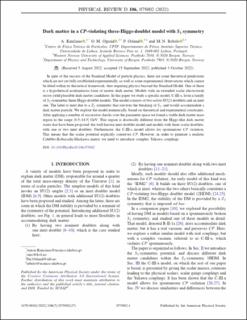| dc.contributor.author | Kuncinas, Anton | |
| dc.contributor.author | Øgreid, Odd Magne | |
| dc.contributor.author | Osland, Per | |
| dc.contributor.author | Rebelo, Margarida N. | |
| dc.date.accessioned | 2023-03-08T12:22:17Z | |
| dc.date.available | 2023-03-08T12:22:17Z | |
| dc.date.created | 2023-01-24T21:41:51Z | |
| dc.date.issued | 2022 | |
| dc.identifier.issn | 2470-0010 | |
| dc.identifier.uri | https://hdl.handle.net/11250/3057065 | |
| dc.description.abstract | In spite of the success of the Standard Model of particle physics, there are some theoretical predictions which are not yet fully established experimentally, as well as some experimental observations which cannot be fitted within its theoretical framework, thus requiring physics beyond the Standard Model. One of these is a hypothetical nonluminous form of matter–dark matter. Models with an extended scalar electroweak sector yield plausible dark matter candidates. In this paper we study a specific model, C-III-a, from a family of S3 -symmetric three-Higgs-doublet models. The model consists of two active SU(2) doublets and an inert one. The latter is inert due to a Z2 symmetry that survives the breaking of S3 , and would accommodate a dark matter particle. We explore the model numerically, based on theoretical and experimental constraints. After applying a number of successive checks over the parameter space we found a viable dark matter mass region in the range [ 6.5 ; 44.5 ] GeV . This region is drastically different from the Higgs-like dark matter states that have been proposed: the well-known inert doublet model and models with three scalar doublets, with one or two inert doublets. Furthermore, the C-III-a model allows for spontaneous C P violation. This means that the scalar potential explicitly conserves CP . However, in order to generate a realistic Cabibbo-Kobayashi-Maskawa matrix we need to introduce complex Yukawa couplings. | en_US |
| dc.language.iso | eng | en_US |
| dc.publisher | APS | en_US |
| dc.rights | Navngivelse 4.0 Internasjonal | * |
| dc.rights.uri | http://creativecommons.org/licenses/by/4.0/deed.no | * |
| dc.title | Dark matter in a CP-violating three-Higgs-doublet model with S3 symmetry | en_US |
| dc.type | Journal article | en_US |
| dc.type | Peer reviewed | en_US |
| dc.description.version | publishedVersion | en_US |
| dc.source.articlenumber | 075002 | en_US |
| cristin.ispublished | true | |
| cristin.fulltext | original | |
| cristin.qualitycode | 1 | |
| dc.identifier.doi | https://doi.org/10.1103/PhysRevD.106.075002 | |
| dc.identifier.cristin | 2114340 | |
| dc.source.journal | Physical Review D | en_US |
| dc.identifier.citation | Physical Review D. 2022, 106, 075002. | en_US |
| dc.source.volume | 106 | en_US |

